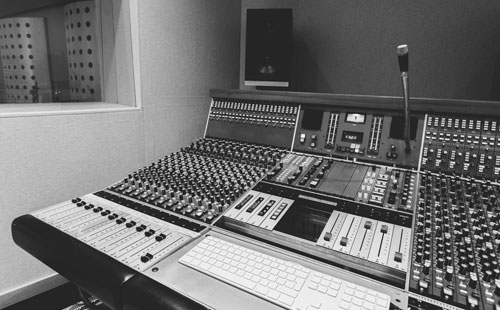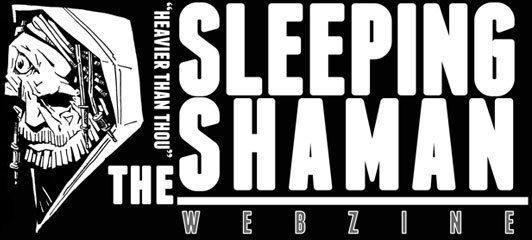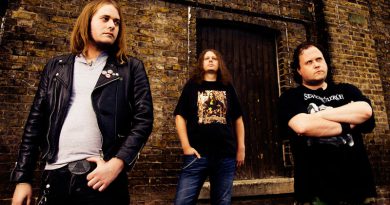SkyHammer: An Interview With Jon Davis About The Concept To Realisation Of His New Studio
It was no real shock when Jon Davis of Conan announced he was building a recording studio, SkyHammer, pretty much from scratch, as from an outsider looking in it seemed like a logical progression, especially when you consider his love of amps! Now the doors are open and the first bands have now started to record there along with resident engineer Chris Fielding, I thought now was a good time to catch up with Jon to ask him about the concept to realisation of building your own studio.

Hey Jon, I hope things have settled down a little since your recent UK Tour, although that could be a stupid question as you prepare to enter the studio to record the follow up to Monnos so your probably busier than ever!
Cheers Lee – good to see you last night ;). things have been cool today I’ve been shooting some targets in the garden with my newly acquired pellet gun and trying to get rid of a cold :/
That also brings us nicely onto the reason of this interview, your studio, SkyHammer, which you have literally built from scratch, so firstly, why?
Well firstly when my Wife and I saw that this house was available we saw that it had some extra buildings and one of them was immediately earmarked as a practice room for Conan. I started to look into it and thought it would be necessary to sound proof it a lot to ensure that it wasn’t so loud the neighbours would be offended. Once we looked into the cost of that I figured it would be cool to set up some sort of recording facility in there – purely so I could maybe learn how to record stuff and maybe earn an income from it. I had progressed along these lines and had bought equipment and consulted with many people I know who work as producers and then one day in February I got a call from Chris Fielding who had the crazy idea that we should run the studio together. The rest is history…..
I dread to think what is involved with a project of this size, so from the initial concept to the finished studio, how long did the project take and were there any major hiccups along the way?
To be totally honest with you it was not quite as arduous as you might think. Sure, it was frustrating seeing it get built so slowly as you want it built YESTERDAY but it started mid-May and was finished late August so really it did not take all that long considering the attention to detail that went into it. Fortunately we did not have many problems along the way – I guess the worst thing that happened having to have most of the roof replaced. We didn’t expect to need that but when we exposed part of the roof cavity it became clear that we needed to do quite a bit to make sure it was structurally sound. That involved knocking down and rebuilding internal walls around the live room and this particular task (building the wall and all the associated digging of foundations etc) seemed to take ages. Once that was done we handed the job over to a company called The Studio People and they just picked it up and ran with it. They were really easy to work with.

Location is vitally important, especially when it comes to noise and not annoying the neighbours so did you purposely look for the right building/location, or was it by accident and you thought, umm this would make a good studio, let’s do it?
Yeah, it was a bit like that where you see it and think “right, let’s just do it” – then you start to think about how you can make it sound proof :). The noisiest room (the live room) is encased within about 3 seperate layers of sound proofing, including a full brick wall and the outside brick wall so between the outside world and the inside of the live room you have an external brick wall, and air gap, a brick built ‘acoustic barrier’ and then multiple layers of rockwool / sound proofing. The live room and the control room are both independently air conditioned with attenuated grills so noise escapes or enters the room through the air vents, each room also has magnetic seals around both doors so airborne sound cannot escape. If a drummer is playing in there you can hear him a little bit outside if you stand near to the walls but the sound dissipates very quickly and so it is highly unlikely that the neighbours would be able to hear anything. It was a huge concern of course but the designers did a good job of keeping all the noise inside the studio.
I know the studio is an annex to your home so how does your family feel about it? It must be incredibly exciting for your kids?
The family love it. The kids in particular enjoy having all these interesting people around. My eldest daughter in particular gets excited if any of the people coming here know anything about horses so I always keep an eye out for that. My wife has been totally supportive of the project too, it was something we decided on together – it wasn’t just my idea fortunately so we both love the fact that right in our garden we have a top notch recording facility with an amazing producer working within it – it’s a dream come true. Of course it also means that I don’t have to drive anywhere for Conan practices which is an added bonus.
As for the actual design, I believe you hired in a specialist to help build the studio, did you find this a huge help and was it worth the money rather than trying to figure it all out yourself?
Yeah we hired a company called ‘The Studio People’ after trying to get designs off a couple of different people who didn’t quite get the brief. It ended up costing us more than we expected but once we saw the final quote we quickly realised that they were going to build us something special and we had no difficulty in justifying the expense. I wanted to make a difference with the studio and the price we paid was well worth it no matter how you look at it. If I had just got designs and had a non-specialist contractor build the place for me it would have taken 10 times longer and may have even costs the same in the long term. One of the key features was the sound proofing in the live room and that was nailed really well so it’s all good.

How did you decide on what actual equipment to install to get the best out of the space available while sticking within budget as I could image you could quite easily get carried away? Also is it purely digital or do you offer analogue recording as well?
All the recording equipment has been provided by Chris Fielding. I have no skills in that department, but fortunately Chris had some awesome gear that he brought up with him from London. We offer a mixture of both types of recording – we have an early Neve desk and a Pro Tools HR computer system – best of both worlds really. I think Chris might get a bit carried away in the long term buying rack gear or microphones or whatever but he would be the best person to do that as I haven’t that much knowledge of those things.
Can you give us a brief rundown of what recording equipment the studio features and as I know you’re an amp junkie, do you also offer the bands use of your backline?
Here is a rundown (nicked from the website for speed)…
Guitar Amps – 1978 Matamp GT120. 1972 pix only Orange OR120. Green Matamp GTL (90’s – built by Dave Green). Sunn Model T. Peavey 5150. Simms Watts AP150 SUPER (can be used for bass or guitar).
Bass Amps – Sunn Colisseum 300. Peavey MK6. Peavey 400 series ‘bass’. Peavey 400 series ‘musician’. Simms Watts AP150 SUPER (can be used for bass or guitar).
Cabs – Matamp 4×12 (hot 100 speakers, 16 ohms). Matamp square front 2×15 (fane speakers – 16 ohms). Orange 4×12 (vintage 30’s – 16 ohms). Sound City 4×12 (vintage 30’s – 16 ohms). Matamp 2×15 tall fronted (Celestion truvox 300’s – 4 ohms). Peavey reverse horn 1×18. Peavey 3620 (2×18 and 2×10 in same enclosure – 4 ohms). SWR 8×10 (1600 watts – 4 ohms).
Drums – Pearl BLX kit. 10, 12, 14, 16 inch toms, 14 inch floor tom, Pearl brass free floating snare.
Desk – Neve 5116 analogue mixing console into a Pro Tools HD computer system.
I guess for any studio, it doesn’t matter what it looks like inside or out as ultimately all that matters is what sound it produces, I’m no acoustics expert so how did you tackle this to make sure you got the best out of the room and was it a nervous time the first time a note was struck and recorded?
Well yeah there is a lot of truth in that but I’m also pretty keen for the place to look good too. The studio internally looks beautiful – the attention to detail and the quality of the materials used is really high and it’s a nice place to go and sit to chat with Chris or the bands or whoever. We love practising there as it is a very welcoming place to be. The colours in there are pretty calm and soothing too. The acoustics in the room were handled by the studio people using their established techniques. The control room is pretty almost anechoic so is very ‘neutral’ sounding (which is desirable so the shape of the room and any reflections do not colour the sound coming from the speakers). The live room is (as you would expect) a bit brighter sounding and this is the room that the instruments are played and sounds recorded. We’ve had a few bands in so far, and I’ve been totally blown away by how good they sound and I’m really excited about recording in there myself.

You’ve also scooped Chris Fielding in as a resident engineer, a man you’ve worked with many times over the years, so how did his involvement in SkyHammer Studio come about?
Well yeah, Chris and I have been friends for years since we record everything with him. He is a great lad to work with and we know we can rely on him. Initially I was going to run the studio myself and try to teach myself how to record bands – developing the business as I went along. Then one night in Feb (I think) this year I got a message from Chris out of the blue asking if I would be free to talk. He then called me and said that he was moving up from London to home (near Chester) and did I want him to work in the studio. I was blown away to be frank and was really excited about the prospect. I spoke to my Wife about it and the next day Chris and I decided to work together – it was a very easy decision.
Now you own your own studio people must constantly say to you, you lucky bastard, you get to record Conan for free, but I assume that’s not quite the reality as the studio has overheads, the engineer needs to be paid etc, so would you like to set the record straight on this matter?
Ha haaa! Conan pay exactly the same as everyone else believe it or not. The studio costs money to run and if we recorded elsewhere we would have to pay anyway so it’s only fair that we pay too. Additionally, if we are turning people away so we can record then it would make no sense at all to record their for free as we are keeping the band and the studio totally separate in financial terms.
SkyHammer is now open for business, so which bands have you had through the door so far, who is in the pipeline and what has the initial feedback been like so far?
We’ve had quite a few bands so far. Bast – Throne – Nathicana – Coltsblood have been in and Serpent Venom are recording here as I type. It’s been so cool to have these people around here, we’ve enjoyed having a laugh and a beer and it’s all very relaxed so people enjoy it. The feedback has been excellent and the quality of the recordings coming from the studio has been superb, it’s so good to know that Chris is able to produce the quality of music that he has.
We’ll draw this interview to a close, thanks for your time Jon, all of us at The Sleeping Shaman wish you a heavy future with your new venture and please use this space to tell people how they can book in at SkyHammer as well as any final words…
Cheers Lee, thanks very much for the support. Anyone can look at the website at www.skyhammerstudio.com and can book at bookings [at] skyhammerstudio [dot] com.
Interviewed by: Lee Edwards
Photo Credit: Matt Thomas



